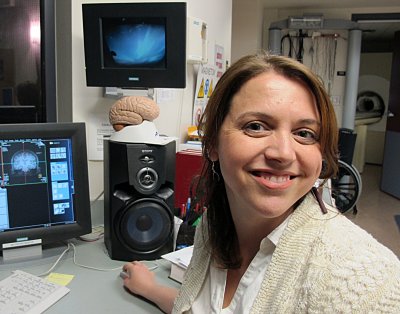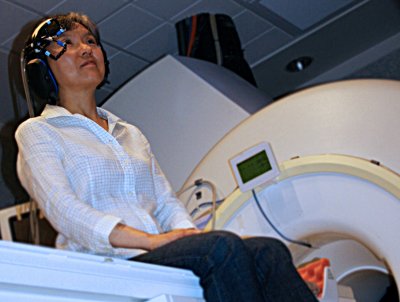EUGENE, Ore. — (July 10, 2012) — Contrary to a common school of thought, the auditory area of the brain of a person born deaf can function even without auditory stimulation, responding instead to vision and touch, researchers at the University of Oregon have found.
 The discovery could influence how deaf people are educated and improve success rates for cochlear implants, said Christina Karns, a postdoctoral research associate in the Department of Psychology and Institute of Neuroscience.
The discovery could influence how deaf people are educated and improve success rates for cochlear implants, said Christina Karns, a postdoctoral research associate in the Department of Psychology and Institute of Neuroscience.
In a paper published in the July 11 online issue of The Journal of Neuroscience, Karns and co-authors Mark Dow and Helen Neville, the Robert and Beverly Lewis endowed chair in psychology and director of the UO Brain Development Lab, show that congenital and profound deafness alter how vision and touch are processed in the primary auditory cortex of the brain, Heschl's gyrus.
The finding suggests that since the developing auditory cortex of profoundly deaf people is not exposed to sound stimuli, it adapts and takes on additional sensory processing tasks.
 Previous research, including studies performed by Neville, has shown that people who are born deaf are better at processing peripheral vision and motion. Deaf people may process vision using many different brain regions, especially auditory areas, including the primary auditory cortex.
Previous research, including studies performed by Neville, has shown that people who are born deaf are better at processing peripheral vision and motion. Deaf people may process vision using many different brain regions, especially auditory areas, including the primary auditory cortex.
However, no one has tackled whether vision and touch together are processed differently in deaf people, primarily because in experimental settings, it is more difficult to produce the kind of precise tactile stimuli needed to answer this question.
 Karns and Dow designed an innovative apparatus that presents sensory air puffs to the face and visual flashes of light via tubes clamped to a special headset. Deaf and hearing adults wore the headset in a magnetic resonance imaging (MRI) scanner, and their brain activity was measured while they responded to the puffs and lights.
Karns and Dow designed an innovative apparatus that presents sensory air puffs to the face and visual flashes of light via tubes clamped to a special headset. Deaf and hearing adults wore the headset in a magnetic resonance imaging (MRI) scanner, and their brain activity was measured while they responded to the puffs and lights.
In deaf participants, Heschl's gyrus exhibited a much stronger response to touch and vision than in hearing participants. The response was twice as strong for touch as for vision, and touch and vision seemed to interact with each other more in the deaf participants, Karns said.
In fact, in some deaf participants the link between touch and vision was so strong that a single flash of light appeared to be two flashes when it was paired with two air puffs, Karns said. Those deaf participants who had the largest response in the primary auditory areas of the brain saw this illusion more often.
"The auditory part of the brain is much more flexible than we thought," Karns said. "In people deaf from birth, it’s able to process vision and touch, and it’s changing what the deaf people are seeing when combined with touch."
"This research shows how the brain is capable of rewiring in dramatic ways," said James F. Battey, Jr., M.D., Ph.D., director of the National Institute on Deafness and Other Communication Disorders, which funded the research. "This will be of great interest to other researchers who are studying multisensory processing in the brain."
The discovery could influence current research on brain development and neuroplasticity (i.e. the changeability of the brain with experience) and support the use of new approaches for the education of deaf people, given how their brains respond to touch, Karns said.
With future studies, the research also could improve success rates for cochlear implants, surgically implanted devices that deliver sound input directly to auditory brain areas through the auditory nerve. These devices work best when implanted in very young children or in adults who became deaf after extensive experience with sound.
But even in good candidates, outcomes are still variable. Deaf people with a strong link between vision and touch in auditory brain regions may not be as receptive to new auditory information so they might require special training to use the device, Karns said.
This research was supported with National Institutes of Health NIDCD funding (5R01DC000128-34), and by an NIH Recovery Act supplement R01DC000128-32S1.
About the University of Oregon
The University of Oregon is among the 108 institutions chosen from 4,633 U.S. universities for top-tier designation of "Very High Research Activity" in the 2010 Carnegie Classification of Institutions of Higher Education. The UO also is one of two Pacific Northwest members of the Association of American Universities.
Media Contact: Matt Cooper, Communications Specialist, Office of Communications, 541-346-8875, mattc@uoregon.edu
Source: Christina Karns, postdoctoral research associate, UO Brain Development Lab, (541) 346-4248, ckarns@uoregon.edu
UO Science on Facebook: http://www.facebook.com/UniversityOfOregonScience
Note: The University of Oregon is equipped with an on-campus television studio with satellite uplink capacity, and a radio studio with an ISDN phone line for broadcast-quality radio interviews. Call the Media Contact above to begin the process.